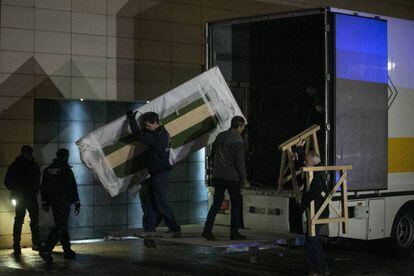One example of how Catalan separatists manipulate history
Catalonia is fighting to keep medieval artworks that were taken from the neighboring region of Aragón

The clash over the return of medieval artworks, originally from the Monastery of Santa María de Sijena in the region of Aragon, is a perfect and clear-cut example of how the Catalan independence movement manipulates history to paint itself as the victim. Let’s look at the facts:
The nuns, who belonged to the Order of Knights of the Hospital of Saint John of Jerusalem, lived in the monastery in Villanueva de Sijena until 1970. But even though they had left, their religious order continued to sell valuable artworks from the monastery to the Catalan regional government, making bulk sales in 1983, 1992 and 1994. For years, the works were left in Catalan museums, given that up until 1995, when the diocese of Barbastro-Monzón was created, the monastery and other parish churches in western Aragón belonged to the diocese of Lleida in Catalonia.
We would have equally rejected this argument if authorities in Salamanca had used it to defend their claim to the Salamanca Papers
But in 1997, it was recognized that the transaction had failed to comply with the legal requisite to inform the Ministry of Culture and the regional government of Aragón, as required by existing laws on historic and artistic heritage. Local authorities and the Aragón regional government then began legal proceedings that ended in 2015 with an adverse ruling for the buyers of the artworks.
The nuns had sold tombs, paintings – even the doors. Fifty-one pieces were initially returned from the Catalan National Art Museum (MNAC), but another 44 (two have gone missing) remained in the Lleida Diocese Museum. The Catalan regional government argues that the works inside the MNAC were not catalogued or protected under Catalan heritage laws, unlike those from Lleida. The Catalan government, claiming the two should be judged separately, planned to appeal to the Supreme Court.
But on November 30 the High Court of Huesca province upheld the 2015 decision which ordered that the works be returned, rejecting the appeal from the Catalan regional government and the MNAC, and arguing that the sales contract was void and that the monastery (and its objects) – which were catalogued as a national monument in 1923 – were “indivisible.” A judge then ruled for the works to be handed over by December 11 – a process that authorities are currently carrying out.
The nuns had sold tombs, paintings – even the doors of the place
Meanwhile, the Sijena convent has been sublet to a French religious order, which is developing chalets in the area.
Given this history, Aragón’s claim is legitimate and straightforward – and the Catalan government is bound to comply with the court ruling. The treasure from Sijena was never taken away from Catalonia, but rather taken away from Aragón with the help of the Lleida diocese, the Vatican and the Catalan regional government. Cultural heritage cannot be built on illegalities and conflict between communities in a democratic country, nor on childish sentiments that don’t hold water in a rational world, but rather on a base of legality and basic respect for common sense.
Separatists are now trying, in the middle of the campaign for the regional elections, to revive the umpteenth narrative of victimization which has characterized their discourse since the Spanish government activated Article 155 of the Constitution. We would have equally rejected this argument if authorities in Salamanca had used it to defend their claim to the Salamanca Papers, a set of over 300,000 documents confiscated from Catalonia after the Civil War and stored for decades in Salamanca. But just as the Salamanca Papers were rightly returned to Catalonia, the treasure of Sijena must be rightly returned to Aragón. It is such an obvious conclusion that trying to rationalize it any other way would sound suspicious.
English version by Melissa Kitson.













































